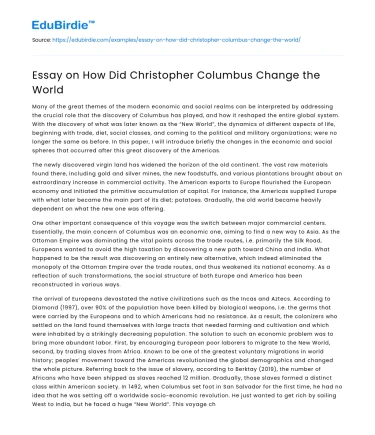Many of the great themes of the modern economic and social realms can be interpreted by addressing the crucial role that the discovery of Columbus has played, and how it reshaped the entire global system. With the discovery of what was later known as the “New World”, the dynamics of different aspects of life, beginning with trade, diet, social classes, and coming to the political and military organizations; were no longer the same as before. In this paper, I will introduce briefly the changes in the economic and social spheres that occurred after this great discovery of the Americas.
The newly discovered virgin land has widened the horizon of the old continent. The vast raw materials found there, including gold and silver mines, the new foodstuffs, and various plantations brought about an extraordinary increase in commercial activity. The American exports to Europe flourished the European economy and initiated the primitive accumulation of capital. For instance, the Americas supplied Europe with what later became the main part of its diet; potatoes. Gradually, the old world became heavily dependent on what the new one was offering.
Save your time!
We can take care of your essay
- Proper editing and formatting
- Free revision, title page, and bibliography
- Flexible prices and money-back guarantee
One other important consequence of this voyage was the switch between major commercial centers. Essentially, the main concern of Columbus was an economic one, aiming to find a new way to Asia. As the Ottoman Empire was dominating the vital points across the trade routes, i.e. primarily the Silk Road, Europeans wanted to avoid the high taxation by discovering a new path toward China and India. What happened to be the result was discovering an entirely new alternative, which indeed eliminated the monopoly of the Ottoman Empire over the trade routes, and thus weakened its national economy. As a reflection of such transformations, the social structure of both Europe and America has been reconstructed in various ways.
The arrival of Europeans devastated the native civilizations such as the Incas and Aztecs. According to Diamond (1997), over 90% of the population have been killed by biological weapons, i.e. the germs that were carried by the Europeans and to which Americans had no resistance. As a result, the colonizers who settled on the land found themselves with large tracts that needed farming and cultivation and which were inhabited by a strikingly decreasing population. The solution to such an economic problem was to bring more abundant labor. First, by encouraging European poor laborers to migrate to the New World, second, by trading slaves from Africa. Known to be one of the greatest voluntary migrations in world history; peoples’ movement toward the Americas revolutionized the global demographics and changed the whole picture. Referring back to the issue of slavery, according to Berktay (2019), the number of Africans who have been shipped as slaves reached 12 million. Gradually, those slaves formed a distinct class within American society. In 1492, when Columbus set foot in San Salvador for the first time, he had no idea that he was setting off a worldwide socio-economic revolution. He just wanted to get rich by sailing West to India, but he faced a huge “New World”. This voyage changed the course of human history. It enriched and empowered Europe, and initiated the growth of modern capitalism. It changed the social makeup and introduced new patterns into both societies.






 Stuck on your essay?
Stuck on your essay?

